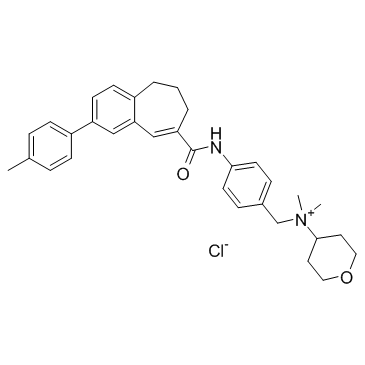TAK-779 (Synonyms: Takeda 779) |
| Catalog No.GC37724 |
An antagonist of CCR5, CXCR3, and CCR2b
Products are for research use only. Not for human use. We do not sell to patients.

Cas No.: 229005-80-5
Sample solution is provided at 25 µL, 10mM.
TAK-779 is a potent and selective nonpeptide antagonist of CCR5 and CXCR3, with a Ki of 1.1 nM for CCR5, and effectively and selectively inhibits R5 HIV-1, with EC50 and EC90 of 1.2 nM and 5.7 nM, respectively, in MAGI-CCR5 cells. MIP-1α-CCR5|1 nM (IC50, in CHO/CCR5 cells)|MIP-1β-CCR5|1 nM (IC50, in CHO/CCR5 cells)|RANTES-CCR5|1.4 nM (IC50, in CHO/CCR5 cells)|MCP-1-CCR2b|27 nM (IC50, in CHO/CCR5 cells)|R5 HIV-1 (Ba-L)|1.2 nM (EC50, in MAGI-CCR5 cells)|R5 HIV-1 (KK)|1.6 nM (EC50, in PBMCs)|R5 HIV-1 (HHA)|3.2 nM (EC50, in PBMCs)|R5 HIV-1 (CTV)|3.5 nM (EC50, in PBMCs)|R5 HIV-1 (Ba-L)|3.7 nM (EC50, in PBMCs)|R5 HIV-1 (Ba-L)|5.7 nM (EC90, in MAGI-CCR5 cells)|R5 HIV-1 (HHA)|7.5 nM (EC90, in PBMCs)|R5 HIV-1 (Ba-L)|12.8 nM (EC90, in PBMCs)|R5 HIV-1 (KK)|20.8 nM (EC90, in PBMCs)|R5 HIV-1 (CTV)|27 nM (EC90, in PBMCs)|mCXCR3|369 nM (IC50, in PBMCs)
TAK-779 is a potent and selective nonpeptide antagonist of CCR5, with a Ki of 1.1 nM, and effectively and selectively inhibits R5 HIV-1, with EC50 and EC90 of 1.2 nM and 5.7 nM, respectively, in MAGI-CCR5 cells. TAK-779 less potently blocks the binding of [125I]-monocyte chemotactic protein 1 to CCR2b in CHO/CCR2b cells, with an IC50 for CCR2b of 27 nM. TAK-779 also completely inhibits the binding of [125I]-RANTES to CHO/CCR5 cells with an IC50 of 1.4 nM. TAK-779 (20 nM) selectively inhibits CCR5-mediated Ca2+-signaling. In addition, TAK-779 shows no inhibition on X4 HIV-1 strains[1]. TAK-779 is an antagonist of CXCR3, and inhibits the migration of T cells but not T cell proliferation[2].
TAK-779 (10 mg/kg per day, s.c.) significantly prolongs the allograft survival of the rat intestinal transplantation model. TAK-779 also decreases the number of CD4+ as well as CD8+ T cells in spleen, blood and recipient mesenteric lymph nodes (MLN)[2]. TAK-779 (150 µg per mouse, s.c.) supppresses the development of experimental autoimmune encephalomyelitis (EAE) in myelin oligodendrocyte glycoprotein (MOG)-immunized C57BL/6 mice. TAK-779 decreases the infiltration of CXCR3 and CCR5 bearing leukocytes into the spinal cord. TAK-779 does not alter myelin oligodendrocyte glycoprotein (MOG)-specific immune responses or affect the potential of MOG-specific T cells to transfer experimental autoimmune encephalomyelitis (EAE)[3].
[1]. Baba M, et al. A small-molecule, nonpeptide CCR5 antagonist with highly potent and selective anti-HIV-1 activity. Proc Natl Acad Sci U S A. 1999 May 11;96(10):5698-703. [2]. Takama Y, et al. Effects of a calcineurin inhibitor, FK506, and a CCR5/CXCR3 antagonist, TAK-779, in a rat small intestinal transplantation model. Transpl Immunol. 2011 Jul;25(1):49-55. [3]. Ni J, et al. The chemokine receptor antagonist, TAK-779, decreased experimental autoimmune encephalomyelitis by reducing inflammatory cell migration into the central nervous system, without affecting T cell function. Br J Pharmacol. 2009 Dec;158(8):2046-56. [4]. Gao P, et al. The unique target specificity of a nonpeptide chemokine receptor antagonist: selective blockade of two Th1 chemokine receptors CCR5 and CXCR3. J Leukoc Biol. 2003 Feb;73(2):273-80.
Average Rating: 5 (Based on Reviews and 35 reference(s) in Google Scholar.)
GLPBIO products are for RESEARCH USE ONLY. Please make sure your review or question is research based.
Required fields are marked with *




















